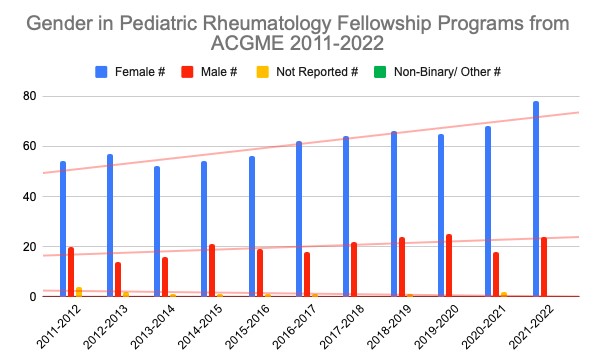Session Information
Session Type: Poster Session C
Session Time: 9:00AM-11:00AM
Background/Purpose: As the demand for pediatric rheumatologists rise across the United States with a projected demand of almost 100% more pediatric rheumatologists needed by 2030 (1), it is essential to create a more balanced healthcare workforce, in hopes of achieving gender equity. We investigated the proportions of male-to-female fellows in pediatric rheumatology from 2011 to 2022 and compared this data to the gender diversity of the current pediatric rheumatology fellowship directors across the country.
Methods: This is a retrospective analysis of data extracted from the Accreditation Council of Graduate Medical Education (ACGME) Data Resource Books from 2011 to 2022. The data collection and trend analysis were conducted on Microsoft Excel. Gender was categorized as male, female and unreported. However, in the last two academic years, non-binary was added as a gender category. Additionally, to identify each pediatric rheumatology fellowship program director, the American Medical Association’s Fellowship and Residency Electronic Interactive Database Access System (FREIDA) was utilized. The pronouns each director used were extrapolated from their publicly available biographies to classify their gender. This data was publicly available therefore, IRB approval was not required.
Results: From 2011 to 2022, the reported data indicate female representation in pediatric rheumatology fellowship programs increased from 69% to 76.50% while the proportion of male fellows decreased from 26% to 23.5%. The representation of female fellows is approximately 40 to 50% higher than their male counterparts for each academic year in the period reported. Moreover, of the 38 pediatric rheumatology fellowship programs, 78.9% of the program directors were female.
Conclusion: More than three-fourths of pediatric rheumatology fellows as well as fellowship program directors are women. These findings are consistent with the 2015 American College of Rheumatology Workforce Study’s overall prediction that women will constitute the majority of the rheumatology workforce by 2025. These results are also consistent with trends within the field of pediatrics with more females in training and pediatric practice (2). Pediatric rheumatology leadership mirrors the pediatric rheumatology pipeline, which is not consistent seen in fields that are predominantly women. Pediatric rheumatology’s leadership pipeline can serve as a model for other fields that are predominantly women. To achieve gender equity in this subspeciality, future studies must examine the underlying causes of this gender shift and explore strategies to ensure broad exposure and recruitment of males into pediatric rheumatology.
To cite this abstract in AMA style:
Roca loor B, Pandit M, Wright T, Etienne M. From Fellow to Fellowship Director: Gender Equity in Pediatric Rheumatology Pipeline [abstract]. Arthritis Rheumatol. 2023; 75 (suppl 9). https://acrabstracts.org/abstract/from-fellow-to-fellowship-director-gender-equity-in-pediatric-rheumatology-pipeline/. Accessed .« Back to ACR Convergence 2023
ACR Meeting Abstracts - https://acrabstracts.org/abstract/from-fellow-to-fellowship-director-gender-equity-in-pediatric-rheumatology-pipeline/

